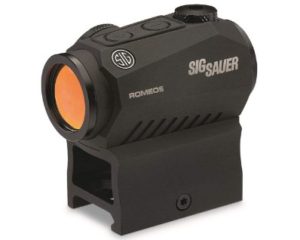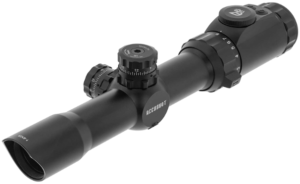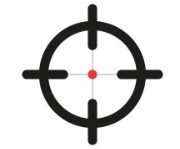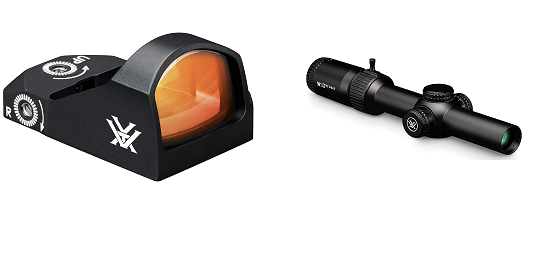Are you searching for an optic that offers reliable performance at 100 yards? In this red dot vs scope at 100 yards comparison, we will share each optic’s important features, pros, and cons. This will help you narrow your search.
When shooting at 100 yards, investing in an optic loaded with essential features like a clear lens, wide field of view, and eye relief is advisable. We created this post to help you make a well-informed purchase.
Red dot sights are designed for close-range shooting applications that require quick target acquisition. They are suitable for hunting or self-defense. However, they have a 1x magnification, which is not ideal for long-range shooting applications.
On the other hand, scopes come with a fixed magnification or variable magnification. This allows you to engage close to long-range targets with ease.
Before selecting any optic for shooting at 100 yards, it is advisable to define your shooting requirements. You need to consider speed, accuracy, weight, and reliability factors.
Let us compare and contrast red dots and scopes to help you find a reliable optic to shoot at 100 yards.
What is a Red Dot?
 A red dot is a close-range sight that is designed for maximum speed. It provides reliable performance when engaging targets at 100 yards or less.
A red dot is a close-range sight that is designed for maximum speed. It provides reliable performance when engaging targets at 100 yards or less.
It is important to note that red dots are non-magnifying sights that project a red dot on the lens to improve precision and accuracy. They are commonly used in firearms such as rifles and shotguns for aiming and quick target acquisition.
Red dots are suitable for beginners who want to hone their shooting skills. They are very easy to use in any lighting condition. This makes them a popular choice for hunting, tactical shooting, and competition shooting.
The other unique feature of red dots is their lightweight and compact design. These sights will not weigh your rifle down.
The major downside of red dots is that they are battery dependent. In addition, they are not ideal for long-range shooting applications. However, you can use a 3 MOA red dot to acquire close range targets
Pros
- Red dots are made from durable materials that can withstand the recoil of most firearms.
- They are very easy to use, making them ideal for beginners who want to hone their precision and accuracy skills.
- They provide increased precision and accuracy at 100 yards.
- They are affordable compared to other sights like holographic sights.
- They have a lightweight and compact design.
- They have a wide field of view, which makes them ideal for shooting applications that require situational awareness.
- You can shoot with both eyes open.
Cons
- Red dots are battery dependent.
- They are not ideal for extreme close-range shooting applications.
- Some red dots are more expensive than scopes.
What is a Scope?
 A scope is an optic that is mounted on a firearm to improve precision and accuracy at varying ranges. They feature a tube equipped with a series of lenses, and a reticle (crosshairs) used to align the sight with the target.
A scope is an optic that is mounted on a firearm to improve precision and accuracy at varying ranges. They feature a tube equipped with a series of lenses, and a reticle (crosshairs) used to align the sight with the target.
Scopes are widely used for hunting, target shooting, and tactical applications. They come in different magnifications and reticle styles to help you hone your precision skills. However, some options have a fixed magnification level.
Many scopes available today are suitable for engaging targets at 100 yards. Some scopes feature adjustable objective lenses that allow the shooter to fine-tune the focus and eliminate parallax. You can also use illuminated scopes in low-lighting conditions to improve target acquisition.
It is worth mentioning that scopes are more durable than red dot sights. Therefore, they can withstand heavy recoil and impact. In addition, you can use them to make accurate shots at distances beyond the capabilities of red dots.
Pros
- Scopes have a variable magnification, allowing you to engage targets at varying distances.
- They are available in different reticles to improve precision and accuracy.
- They feature adjustable lenses that can be used to make accurate shots at distances beyond the capabilities of red dots.
- The lenses are illuminated, which makes them suitable for low-lighting conditions.
- They are more durable than red dots.
- You can use them for hunting, target shooting, and tactical applications.
- You can use some scopes to make adjustments to compensate for the trajectory of a bullet.
Cons
- Scopes are heavier than red dots, which can affect maneuverability.
- They have a limited field of view.
- Adjusting the magnification takes time.
Frequently Asked Questions Red Dot Vs Scope at 100 Yards
- Is it possible to shoot accurately at 100 yards with a red dot?
Yes, it is possible to shoot accurately at 100 yards with a red dot. However, it is more challenging compared to using a scope. This is because red dots offer no magnification and have limited range capabilities.
- What is the advantage of a scope over a red dot at 100 yards?
A scope offers fixed or variable magnification, which makes it easier to aim accurately at longer distances. Scopes also have many reticle options to compensate for bullet drop, making them ideal for long-range shooting.
- Which is better for 100 yard shooting, a red dot or a scope?
It depends on the shooting activity and personal preference. A red dot is a good choice if you are looking for quick target acquisition and close- to medium-range shooting. On the other hand, a scope is better if you want to make more precise shots at longer distances.
Conclusion
By now, we are sure you know the scope you will use for engaging targets at 100 yards. However, the choice ultimately depends on your shooting preferences. This is why it is advisable to define your requirements to make the selection process easy.
Red dots and scopes have pros and cons, but they will help you hone your precision and accuracy skills. Red dots have a lightweight and compact design, making them a good option for those who prefer simplicity and speed.
On the other hand, scopes offer more precise aiming and increased accuracy at longer ranges. They are loaded with many impressive features worth checking out.
We hope this post helped you understand the difference between a red dot and scope when engaging targets at 100 yards. You can check out ACOG Vs Red Dot.

